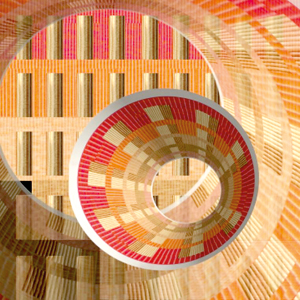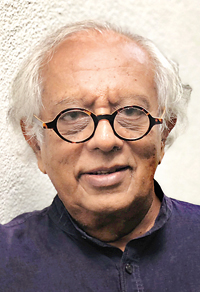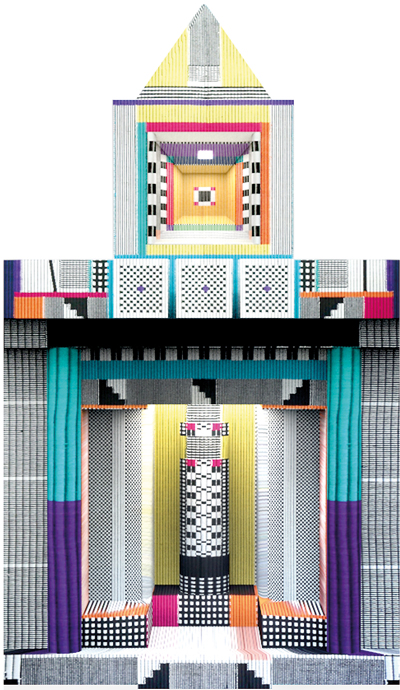Enter Tilak’s 3D weaves

Reconstructed tapestry in animation
It’s the beginning of another architectural aesthetic which can eventually be constructed, says Tilak Samarawickrema unveiling his latest creation. Playing around on the computer, the clean lines and geometric shapes that have been his signature style in tapestry have assumed three dimensional form- the outlines of buildings, temples emerging, windows and doorways, thresholds that beckon you to step over. He is visualizing installations, they can be built, he thinks, rather pleased with what a few days work has generated.
It is, in fact, typical that every meeting with the architect-artist-designer over the years has been a discovery of sorts, given his uncanny propensity to tap into something new. Long years ago it was his tapestries we came to see, some years ago his finely wrought wire sculptures, more recently his art taking on animated form in a cricket commercial made for the T20 World Cup, even tapestry animation to Miles Davis’ jazz.
Tilak turned 75 on the first of September, and if anything, the past decade has seen fresh impetus – the release of two autobiographical volumes, an issue of the local edition of the Domus magazine dedicated to him, (only the third architect after Geoffrey Bawa and Ulrik Plesner to be so featured) and a retrospective exhibition encompassing his art and design over 50 years. Last year, he was on the shortlist for the prestigious Geoffrey Bawa awards for his Mihila factory of 2008, revealing yet another side to the man more renowned as an artist and designer who has drawn with such vision and flair from his heritage- here the uncompromisingly modern architect conceiving a state-of-the-art ‘green’ industrial building.

Tilak Samarawickrema
He is first and foremost, an architect, he says, his design rooted in that discipline and training. Surprisingly though he completed his Inter-RIBA at the University of Moratuwa back in 1968 and did his Masters in Architecture in 1986, it was only in 1999/ 2000 that he established his own architectural firm. “Karma took me away from architecture,” he quips, adding that his life cycle has unfolded in decades, through a pattern of fortuitous meetings that led him down paths that he would not have thought possible as a rebellious student, who went into architecture when he couldn’t qualify for engineering, initially even doubting his ability to draw. That self-doubt soon fell away and while interning during holidays at the offices of Edwards, Reid and Begg under Geoffrey Bawa he fell into the habit of doodling. It grew on him and he discovered there was a serious art form in those quirky, curly lines done with his rapidograph (the architect’s pen) – one writer later hailing him as a Sri Lankan Aubrey Beardsley!
When a few years later having left for Italy on an architectural scholarship, these drawings now grown into a sizeable portfolio which he was in the habit of carrying around with him in a large bag “like a salesman” would captivate the sophisticated design world of Milan. Gallery owners, designers, architects and critics alike, personalities like Lanfranco Colombo, Bruno Munari and Pierre Restany embraced his work opening those formidable Italian doors into the artistic salons and studios of the city’s design elite. I had this Milanese patronage, he reflects. “Maybe it was because I came from this magical island that they were just discovering. It was from this Milan base that I spread out.”
Restany was a keen observer, friend and admirer of Tilak’s work: “Your calligraphy is the image of your language, of the Sinhalese alphabet composed of curves, scrolls and arches, the small of a back, breasts and navels…,” the critic wrote. “Over and above Andare and his school friends and companions, over and above the village and its ceremonies, the weaving lines of your drawings bring us a warm reflection, an exuberant image of work and days of Sri Lanka.”
Back home, scholar Ian Goonetileke writing in 1982 in the exhibition catalogue for the UNESCO National Commission described it as “his gift of transcendant calligraphy, especially when it embodies the power to seduce, fascinate and transmute our routine imaginations.”

Transformation: Tilak’s tapestry in 3D form
It was in those early days in Italy that Tilak first plunged into animation with ‘Andare of Sri Lanka’ produced by Corona Cinematographica and shown at the Oberhausen Film Festival in 1978 as an Italian entry, the film winning a special award from the Italian Ministry of Cultural Affairs .
From Milan he headed to Rome, encouraged by architect and archaeologist Roland de Silva to do the course at ICROM – the International Centre for Conservation and Preservation of Historic Sites and Monuments that Roland himself had been the first Sri Lankan to follow. In Urbino, he learnt the art of stone etchings and lithography – that too would be later transmitted to his copper-plate etchings.
From Rome, he ventured to New York, after a chance meeting with American Peggy Chisholm at the Sapumal Foundation while on holiday back home. Harry Abrams, renowned publisher and art collector bought his work and an exhibition at the Rizzoli Gallery on 5th Avenue followed – more doors opening.
After 12 heady years of Bohemian living in Italy, having tasted success as an artist, imbibed the Bauhaus ethos and flirted with the edgy radical design of the Memphis Movement launched by Italian architect Ettore Sottsass, it was time to come home. And so began another chapter.
Ananda Coomaraswamy’s epic ‘Medieval Sinhalese Art’ had fascinated Tilak as a student and in 1987 when as ILO Design Consultant he came to the National Design Centre, it was his moment to bring the contemporary design aesthetic he had absorbed in Italy to the local crafts hidebound by tradition. Given a free hand by NDC chairman Vernon Peiris, Tilak and his small team roamed the country, combing remote villages, and forgotten valleys for craftsmen doing authentic work. His book ‘A Voyage in Sri Lankan Design- arts, crafts and architecture’ pays tribute to these humble unsung men and women – the gypsy women weavers of Kanatoluwa, the women potters of Alawwa, the Dumbara mat weavers of Henawela and so many more.
Within ten months, he had set up a Design Unit at the NDC and put together the first Silpa exhibition. It was an unqualified success. Bawa, Minette de Silva, Senaka Bandaranayake and other leading figures visited and the latter paid him a rare compliment telling him on the phone that had Coomaraswamy been alive, he would have been very happy.
It was a brief stint though and there are lingering regrets that he could not continue this work though he did return in 2013 to the NDC, with a flurry of design initiatives and another successful exhibition, this time too cut short by bureaucratic pressures.
His tapestry work is a significant component of his design legacy. Initially meticulously hand drawn and painstakingly created by the weavers of Thalagune in Uda Dumbara their distinctive style was quickly recognised in the West – in Switzerland, Italy, Germany and Norway where he had solo exhibitions in fashionable design stores and museums, New York’s MOMA design store too carrying them for eight years.
It was not easy breaking into colour from his black and white line drawings, he admits. Colour predominates now, and he brings out a recent tapestry tracing in its warm vibrant tones the influence of the Buddhist flag and temple murals. Growing up, absorbing the temple and kovil atmosphere, his early work showed the influences of thoranas and even traditional dance costumes.
Today there is immense freedom in working with a computer – directing his young assistants and skilled graphics artists to create, animate, deconstruct and transform as his creative impulse drives him.
His home too has seen transformation: his former studio and other now less utilised rooms turned into extremely successful Air BnB spaces- visitors delighted by their minimalist modern ambiance and the close encounters with Tilak’s unique designs – the brass wire Garuda bird standing loftily in the garden, the delicate wire sculptures suspended in the hall, tapestries and crafts made over the years.
Now discovering a new generation of fans through Facebook, he wishes that he could have had more opportunities to impart his design experience to students. Yet he is full of hope for the promising young architects coming out of Katubedda – 80 percent of them are from rural backgrounds -they are rooted here, with a strong feeling of our culture, and yet very clever to adapt to the contemporary mould, he says with genuine admiration, perhaps seeing in them echoes of the young man who boldly strode into unchartered territory to forge his own distinct design imprint.


